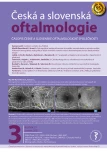DRY EYE DISEASE. A REVIEW
Authors:
M. Zemanová
Authors place of work:
Oční klinika Fakultní nemocnice a Lékařské fakulty Masarykovy Univerzity, Brno
Published in the journal:
Čes. a slov. Oftal., 77, 2021, No. 3, p. 107-119
Category:
Přehledová práce
doi:
https://doi.org/10.31348/2020/29
Summary
This article provides a comprehensive view of the issue of dry eye. It emphasizes provisions of the Tear Film and Ocular Surface Society, discusses the new classification and definition of dry eye based on its pathophysiology, and emphasizes the correct diagnostic and therapeutic approaches, which appears in the form of algorithms.
Dry eye is a multifactorial disease of the ocular surface characterized by a loss of homeostasis of the tear film, and accompanied by ocular symptoms, in which tear film instability and hyperosmolarity, ocular surface inflammation and damage, and neurosensory abnormalities play etiological roles.
Dry eye disease is a dynamic and complex disease of the ocular surface and ocular adnexa with known risk factors. It is a disease with a cyclical character, in which the most important step is to find the etiological trigger, to restore homeostasis and break the vicious circle. The key elements in the diagnosis are increased osmolarity of the tear film and inflammation of the ocular surface, which are accompanied by ocular symptoms (discomfort, visual disturbance). Inflammation is not always associated with hyperemia and can be confirmed by several techniques and methods. However, in current clinical practice, there is still no "gold standard" and sufficient tests to diagnose inflammation of the ocular surface. The treatment of dry eye disease must be individualized, dynamic and optimized for each stage of the disease.
Keywords:
dry eye disease – TFOS – DEWS – DEWS II – vicious circle – ADDE – EDE – MGD
Zdroje
1. Nelson JD, Craig JP, Akpek EK, et al. TFOS DEWS II Introduction. Ocul Surf. 2017;15(3):269-275.
2. Craig JP, Nelson JD, Azar DT, et al. TFOS DEWS II Report Executive Summary. Ocul Surf. 2017;15(4):802-812.
3. Craig JP, Nichols KK, Akpek EK, et al. TFOS DEWS II Definition and Classification report. Ocul Surf. 2017;15(3):276-283.
4. Sullivan DA, Rocha EM, Aragona P, et al. TFOS DEWS II Sex, Gender, and Hormones Report. Ocul Surf. 2017;15(3):284-333.
5. Stapleton F, Alves M, Bunya VY, et al. TFOS DEWS II Epidemiology Report. Ocul Surf. 2017;15(3):334-365.
6. Bron AJ, dePaiva CS., Chauhan, SK, et al: TFOS DEWS II Pathophysiology report. Ocul Surf. 2017;15(3):438-510.
7. Willcox MDP, Argüeso P, Georgiev GA, et al. TFOS DEWS II Tear Film Report. Ocul Surf. 2017;15(3):366-403.
8. Belmonte C, Nichols JJ, Cox SM, et al. TFOS DEWS II pain and sensation report. Tear Film Report. Ocul Surf. 2017;15(3):404-437.
9. Gomes JAP, Azar DT, Baudouin C, et al. TFOS DEWS II iatrogenic report. Ocul Surf. 2017;15(3):511-538.
10. Wolffsohn JS, Arita R, Chalmers R, et al. TFOS DEWS II Diagnostic Methodology report. Ocul Surf. 2017;15(3):539-574.
11. Jones L, Downie LE, Korb D, et al. TFOS DEWS II Management and Therapy Report. Ocul Surf. 2017;15(3):575-628.
Štítky
OftalmologieČlánek vyšel v časopise
Česká a slovenská oftalmologie

- Stillova choroba: vzácné a závažné systémové onemocnění
- Diagnostický algoritmus při podezření na syndrom periodické horečky
- Kontaktní dermatitida očních víček
- Normotenzní glaukom: prevalence a zásady terapie
- Stillova choroba aneb systémová forma juvenilní idiopatické artritidy
Nejčtenější v tomto čísle
- SYNDROM SUCHÉHO OKA. PŘEHLED
-
SKOTÓMY V ZORNOM POLI AKO PRVÝ PRÍZNAK INTRAKRANIÁLNEJ EXPANZIE.
KAZUISTIKA - NEUROTIZACE ROHOVKY U TĚŽKÉ FORMY NEUROTROFICKÉ KERATOPATIE. KAZUISTIKA
- CYKLOKRYOKOAGULÁCIA U SEKUNDÁRNYCH NEOVASKULÁRNYCH GLAUKÓMOV A NAŠE VÝSLEDKY
